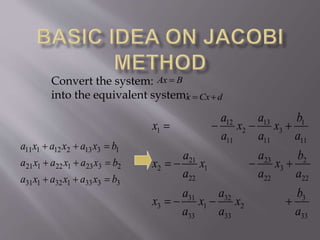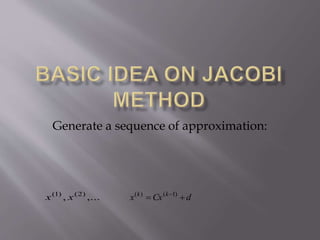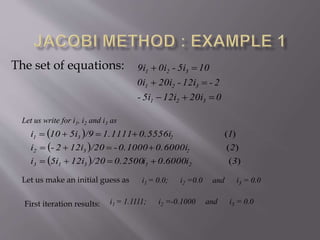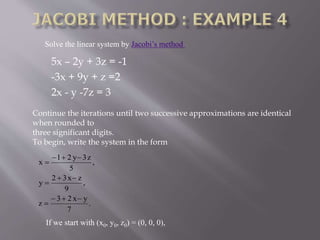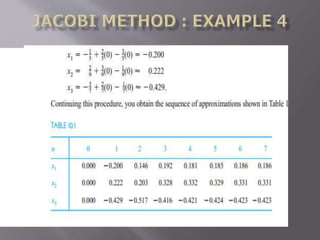Jacobi method
- 2. Convert the system: into the equivalent system: dCxx ïŦï― 3333132131 2323122121 1313212111 bxaxaxa bxaxaxa bxaxaxa ï―ïŦïŦ ï―ïŦïŦ ï―ïŦïŦ 33 3 2 33 32 1 33 31 3 22 2 3 22 23 1 22 21 2 11 1 3 11 13 2 11 12 1 a b x a a x a a x a b x a a x a a x a b x a a x a a x ïŦïïï― ïŦïïï― ïŦïïï― BAx ï―
- 3. Generate a sequence of approximation: ,..., )2()1( xx dCxx kk ïŦï― ï )1()(
- 4. nnnnnn nn nn bxaxaxa bxaxaxa bxaxaxa ï―ïŦïŦïŦ ï―ïŦïŦïŦ ï―ïŦïŦïŦ ï ï ï ï 2211 22222121 11212111 ïš ïš ïš ïš ïš ïŧ ïđ ïŠ ïŠ ïŠ ïŠ ïŠ ïŦ ïĐ ï― 0 0 2 0 1 0 nx x x x ï )( 1 0 1 0 2121 11 1 1 nn xaxab a x ïïïï― ï )( 1 0 2 0 323 0 1212 22 1 2 nn xaxaxab a x ïïïïï― ï )( 1 0 11 0 22 0 11 1 ïïïïïïï― nnnnnn nn n xaxaxab a x ï ïš ïŧ ïđ ïŠ ïŦ ïĐ ïïï― ïĨ ïĨ ï ï― ïŦï― ïŦ 1 1 1 1 1 i j n ij k jij k jiji ii k i xaxab a x
- 5. Consider the two-by-two system Start with Simultaneous updating New values of the variables are not used until a New iteration step is begun 4 11 3 4 1 3 2 1 4 11 3 4 1 3 2 1 )1()2( )1()2( ï―ïŦïï―ïŦïï― ï―ïŦïï―ïŦïï― xy yx 62 62 ï―ïŦ ï―ïŦ yx yx 3 2 1 3 2 1 ïŦïï― ïŦïï― xy yx )1( x )1( y )2( y )2( x
- 7. The set of equations: 020i12i5i- 2-12i-20i0i 105i-0i9i 321 321 321 ï―ïŦï ï―ïŦ ï―ïŦ Let us write for i1, i2 and i3 as ïĻ ïĐ ïĻ ïĐ ïĻ ïĐ )(. )( )( 3i60000i0.2500/2012ii5i 20.6000i0.1000-/2012i2-i 10.5556i1.1111/95i10i 21313 232 231 ïŦï―ïŦï― ïŦï―ïŦï― ïŦï―ïŦï― Let us make an initial guess as i1 = 0.0; i2 =0.0 and i3 = 0.0 First iteration results: i1 = 1.1111; i2 =-0.1000 and i3 = 0.0
- 8. First iteration results: i1 = 1.1111; i2 =-0.1000 and i3 = 0.0 Second iteration results: i1 = 1.1111; i2 =-0.1000 and i3 = 0.22 Third iteration results: i1 = 1.23; i2 = 0.03 and i3 = 0.22 Fourth iteration results: i1 = 1.23 ; i2 = 0.03 and i3 = 0.33 Fifth iteration results: i1 = 1.29; i2 = 0.1 and i3 = 0.33 Sixth iteration results: i1 = 1.29; i2 = 0.1 and i3 = 0.38 ïĻ ïĐ ïĻ ïĐ ïĻ ïĐ )(. )( )( 3i60000i0.2500/2012ii5i 20.6000i0.1000-/2012i2-i 10.5556i1.1111/95i10i 21313 232 231 ïŦï―ïŦï― ïŦï―ïŦï― ïŦï―ïŦï―
- 9. Consider the following set of equations. 15 11 25 6 83 102 311 210 432 4321 4321 321 ï― ïï― ï― ï― ïŦï ïïŦï ïŦïïŦï ïŦï xxx xxxx xxxx xxx Convert the set Ax = b in the form of x = Tx + c. 8 15 8 1 8 3 10 11 10 1 10 1 5 1 11 25 11 3 11 1 11 1 5 3 5 1 10 1 324 4213 4312 321 ïŦïŦïï― ïïŦïŦïï― ïŦïïŦï― ïŦïï― xxx xxxx xxxx xxx
- 12. Results: iteration 0 1 2 3 0.0000 0.6000 1.0473 0.9326 0.0000 2.2727 1.7159 2.0530 0.0000 -1.1000 -0.8052 -1.0493 0.0000 1.8750 0.8852 1.1309 )( k x1 )( k x2 )( k x3 )( k x4
- 13. Solve the linear system by Jacobiâs method 4x -y + z = 7 4x -8y+ z = -21 -2x + y + 5z = 15. From the system of linear equation we get: . 5 yx215 z , 8 zx421 y , 4 zy7 x 1n1n n 1)(n1)(n n 1)(n1)(n n ïï ïï ïï ïïŦ ï― ïŦïŦ ï― ïïŦ ï― If we start with (x0, y0, z0) = (0, 0, 0), . 5 yx215 z , 8 zx421 y , 4 zy7 x ïïŦ ï― ï ïŦïŦ ï― ïïŦ ï―
- 14. . 5 yx215 z , 8 zx421 y , 4 zy7 x 1n1n n 1)(n1)(n n 1)(n1)(n n ïï ïï ïï ïïŦ ï― ïŦïŦ ï― ïïŦ ï― znynxnn 0000 32.6251.751 3.1753.8751.6562 2.8873.851.9253 33.9481.994 2.9973.9951.995 2.9973.9951.99956 The iteration appears to converge to the solution (2, 4, 3) JACOBI METHOD:EXAMPLE 3
- 15. 5x â 2y + 3z = -1 -3x + 9y + z =2 2x - y -7z = 3 Solve the linear system by Jacobiâs method Continue the iterations until two successive approximations are identical when rounded to three significant digits. To begin, write the system in the form If we start with (x0, y0, z0) = (0, 0, 0), . 7 yx23 z , 9 zx32 y , 5 z3y21 x ïïŦï ï― ïïŦ ï― ïïŦï ï―
- 17. #include<stdio.h> #include<conio.h> #include<math.h> #define ESP 0.0001 #define X1(x2,x3) ((17 - 20*(x2) + 2*(x3))/20) #define X2(x1,x3) ((-18 - 3*(x1) + (x3))/20) #define X3(x1,x2) ((25 - 2*(x1) + 3*(x2))/20) void main() { double x1=0,x2=0,x3=0,y1,y2,y3; int i=0; clrscr(); printf("n__________________________________________n"); printf("n x1tt x2tt x3n"); printf("n__________________________________________n"); printf("n%ft%ft%f",x1,x2,x3); do {
- 18. y1=X1(x2,x3); y2=X2(x1,x3); y3=X3(x1,x2); if(fabs(y1-x1)<ESP && fabs(y2-x2)<ESP && fabs(y3-x3)<ESP ) { printf("n__________________________________________n"); printf("nnx1 = %.3lf",y1); printf("nnx2 = %.3lf",y2); printf("nnx3 = %.3lf",y3); i = 1; } else { x1 = y1; x2 = y2; x3 = y3; printf("n%ft%ft%f",x1,x2,x3); } } while(i != 1); getch(); }
- 19. x1 x2 x3 0.000000 0.000000 0.000000 0.850000 -0.900000 1.250000 1.875000 -0.965000 1.030000 1.918000 -1.129750 0.917750 2.071525 -1.141812 0.888737 2.080686 -1.166292 0.871576 2.103449 -1.168524 0.866988 2.105223 -1.172168 0.864376 2.108606 -1.172565 0.863653 2.108930 -1.173108 0.863255 2.109434 -1.173177 0.863141 __________________________________________ x1 = 2.109 x2 = -1.173 x3 = 0.863 Outpu t:

